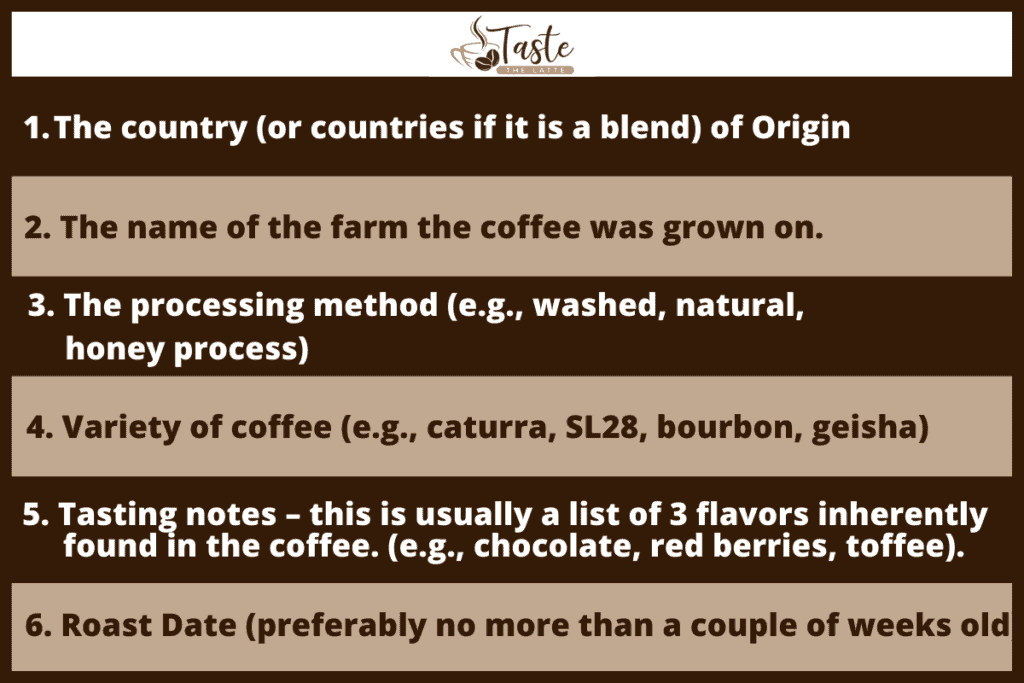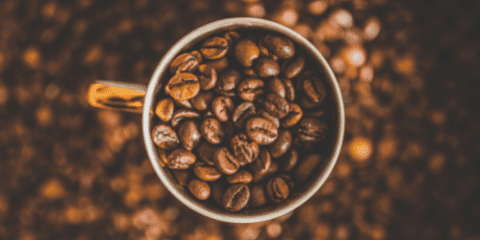You want to buy a good quality coffee bean to make that delicious cup of coffee with, but how do you go about doing so? The endless coffee brands on store shelves and the tremendous variety on the internet can be daunting at times. I only seek after quality beans, but how do I know the good, the bad, and the ugly?
How can you tell the quality of coffee beans? The only true way to determine the quality of coffee beans is by tasting them. Thankfully, before the coffee beans reach your bag, they will likely have been tasted multiple times already by the farmer, Q Graders (professional coffee taster), importer, and coffee roaster.
The information communicated to you on the bag or at the point of sale will help you determine quality.
Keep an eye out for the following to determine the quality of coffee beans.

Generally speaking, the more information, the better. It would be best to buy from a roaster or brand you trust/prefer. It is possible to buy the best quality green beans in the world but then roast them poorly and lose all the complex flavors that made them good in the first place.
Coffee’s Country of Origin
Assuming you’re buying quality coffee beans (or ground coffee) from a roaster or brand you like, we can now look at what general characteristics you can expect from coffee from different coffees from different countries. So here are my Top 8 Coffee Producing Countries (ordered by continent).
Top 8 Countries for Producing Coffee
- Kenya
- Ethiopia
- Rwanda
- Indonesia
- Brazil
- Colombia
- El Salvador
- Panama
Click the link to read more on “What Country Does the Best Coffee Come From?”
Coffee Grading
Historically, coffee beans have been graded by size since this was thought to be linked to quality. However, size is not necessarily related to quality (bigger isn’t always better). What will help the quality of the coffee you drink is if the beans in your bag are of a uniform size.
This is because you can only achieve a consistent roast with similar coffee beans (you can’t take out the small beans that are done first and leave the bigger beans in for longer).
But it’s not very often you will see a grade (or with Specialty coffee an SCA score) on the bag, and you can’t see what’s in the bag until you’ve bought it, so here are some tips on how to pick the best quality coffee.
The Roasting Process and Bean Quality
Even if you purchase Arabica coffee beans from one of the top producing coffee countries, you still have to consider how they are roasted.
A coffee roaster roasts, or cooks, the green coffee beans. When the beans are loaded into the roaster, they are dropped into a very hot (around 200c) drum. A series of reactions will then alter the taste of the bean from an almost tasteless green bean into a brown roasted coffee bean.
The person working the coffee roaster plays a crucial role in producing a high quality bean. They control a handful of roasting variables, including how hot the coffee gets and how long it is roasted. Ultimately, they control the flavors we taste in the coffee we drink.
High quality beans aren’t all the same as you can have lighter roasts, medium roasts, and dark roasts. The roast profile is a personal preference of the coffee drinker.
Choosing Quality Beans at the Supermarket
It’s all about information. You would not buy a second-hand car without knowing how many miles were on the clock and how many owners it had. And if the seller wasn’t willing to disclose these facts, then you’d walk away. The same applies to coffee. The more information available, the more likely it will genuinely be good. The minimum amount of information I would buy supermarket coffee on is:
- What beans are in the bag? If there is not a single bit of information telling you what country the beans, walk away.
- The word “arabica” is often used as a marketing tool to denote quality. Arabica is the best (and most grown) species of coffee, and if it’s written on the bag, you at least know they have not sneaked any Robusta in there. Conversely, however, you would not see this written on a bag of the best quality coffee beans bought from a specialty coffee roaster. This is due to the fact that it would be a given that it was arabica.
- Tasting notes – It’s important that these are flavors like chocolate and hazelnut. Words like “dark roasted” or “intense” are more likely to indicate how the coffee is roasted, not its quality.
- Roast date trick: Most supermarkets dictate to coffee roasters that they must have a year’s shelf life on their coffee. So, if you look at the best before date on the bag, the best before date will probably be a year from the roast date. If you work it back, you can ensure you have freshly roasted coffee.
Choosing Quality Beans at the Coffee Shop
This is much easier than the supermarket and is most likely higher quality coffee. If you choose to buy your coffee in a shop where you drink and enjoy their coffee already, you’re already giving yourself an amount of certainty that you’re going to enjoy what you buy.
The best thing you can do in a coffee shop is going up to the shelf and have a good look at what they offer. Once you’ve done that, have a good chat with the staff in the coffee shop. If they’re selling good quality coffee, it’s likely the staff would have tasted the majority of it and should be able to make you a good recommendation based on what you tell them you like.
They may also ask you what you’re brewing the coffee in (e.g., French Press, Aeropress, espresso machine) and may offer to grind the coffee for you. If the staff has no idea about the coffee beans they are selling and using, it’s unlikely it will be quality coffee.
Buying Coffee Online
Buying coffee online can be a bit of a minefield. There are so many options and an infinite number of websites. An excellent place to start is to find out who your favorite coffee shop buys their coffee from. Then see if the roaster has a website you can purchase from.
If they do, and there is plenty of information on the coffee, you will likely buy something you enjoy. If you are after good quality coffee and have no starting point, I recommend starting by Googling “specialty coffee.” Buying coffee deemed “specialty” means the green coffee the roaster has purchased is of high quality.
Finally, buying your coffee online directly from the person who has roasted it is usually a good sign of quality. Buying it through a third-party website like Amazon lessons the likelihood it is of higher quality.
How to Tell the Quality of Beans you Bought
Once you have the bag of beans in your hands and opened them, there are a few ways to tell good quality coffee.
- Are all the beans of uniform size? If they all look similar, and there are no giant beans or broken beans, this is a good sign. Broken beans, in particular, are a bad sign. A bag made up of lots of broken beans is a low-quality bag of coffee.
- Are your coffee beans brown and matte or black and shiny? If your beans are brown and matte in color, this is a sign they are roasted well. If they have been roasted to a point where they are black and have a glossy appearance, it’s likely they’ve been over-roasted. The color denotes they’ve been in the roaster for a long time. The shininess of the beans shows that the oils have come to the surface. Oils come to the surface when the coffee has been overdeveloped, and you will find the delicate flavors have turned into more bitter flavors.
- How do they taste? Ultimately this is all that matters. If you enjoy the coffee, buy more from the same roaster/brand. If not, use the principles laid out in this blog to try somewhere new.
Storing your Quality Coffee
You’ve gone through all the effort of finding quality coffee beans, now you have to keep them that way. The beans’ freshness depends on how you store them and how long it takes you to use them.
Let’s talk storage. Proper coffee storage can be the difference between a fresh cup of delicious coffee and a stale cup of bland coffee. Quality coffee beans will always come in an airtight bag with a one-way valve. This valve allows Carbon Dioxide, CO2 to exit while preventing oxygen from coming in.
Once opened, transfer the beans to an opaque coffee container like a Coffee Gator or Airscape. Check out “Coffee Gator vs. Airscape: Which container is Best?”
Always store is a dark place away from any moisture.
For more tips on how to keep your beans fresh and tasting their best, click here.
